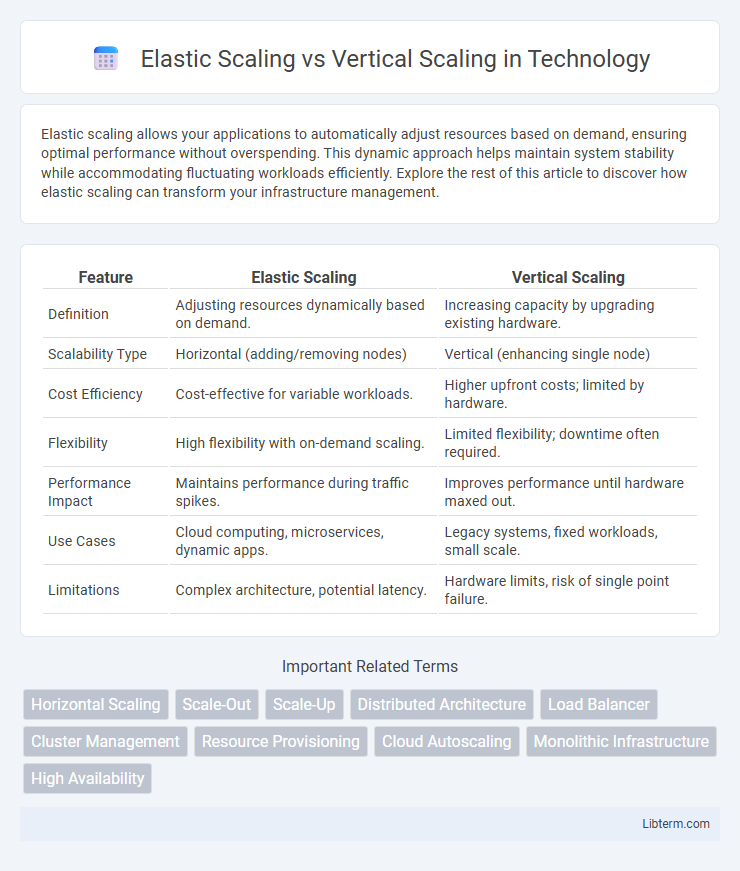Elastic scaling allows your applications to automatically adjust resources based on demand, ensuring optimal performance without overspending. This dynamic approach helps maintain system stability while accommodating fluctuating workloads efficiently. Explore the rest of this article to discover how elastic scaling can transform your infrastructure management.
Table of Comparison
| Feature | Elastic Scaling | Vertical Scaling |
|---|---|---|
| Definition | Adjusting resources dynamically based on demand. | Increasing capacity by upgrading existing hardware. |
| Scalability Type | Horizontal (adding/removing nodes) | Vertical (enhancing single node) |
| Cost Efficiency | Cost-effective for variable workloads. | Higher upfront costs; limited by hardware. |
| Flexibility | High flexibility with on-demand scaling. | Limited flexibility; downtime often required. |
| Performance Impact | Maintains performance during traffic spikes. | Improves performance until hardware maxed out. |
| Use Cases | Cloud computing, microservices, dynamic apps. | Legacy systems, fixed workloads, small scale. |
| Limitations | Complex architecture, potential latency. | Hardware limits, risk of single point failure. |
Introduction to Scaling in Cloud Computing
Elastic scaling in cloud computing allows resources to dynamically adjust based on demand, enabling rapid allocation or deallocation of compute power and storage to optimize performance and cost-efficiency. Vertical scaling involves upgrading the capacity of existing hardware by adding more CPU, RAM, or storage to a single server, improving performance but with limited scalability and potential downtime. Elastic scaling supports flexible, real-time resource management essential for handling unpredictable workloads, while vertical scaling suits steady or predictable processing needs with simpler infrastructure adjustments.
What is Elastic Scaling?
Elastic scaling is a cloud computing feature that automatically adjusts computing resources based on real-time demand, ensuring optimal performance and cost-efficiency. It dynamically increases or decreases CPU, memory, and storage capacities without downtime, supporting fluctuating workloads in distributed systems. This approach contrasts with vertical scaling, which involves manually upgrading a single server's hardware to handle increased load.
What is Vertical Scaling?
Vertical scaling, also known as scaling up, involves increasing the capacity of a single server or machine by adding more CPU, RAM, or storage to handle higher workloads. This approach improves performance within the existing infrastructure but has physical and cost limitations based on hardware capabilities. Vertical scaling is commonly used in databases and legacy systems where scaling out to multiple machines is complex or unsupported.
Key Differences Between Elastic and Vertical Scaling
Elastic scaling dynamically adjusts computing resources by automatically adding or removing instances based on demand, offering flexibility and cost efficiency. Vertical scaling involves upgrading the capacity of a single server, such as increasing CPU, RAM, or storage, which provides simplicity but limited scalability and potential downtime. Key differences include elasticity, resource allocation method, cost impact, and downtime risks, with elastic scaling favoring distributed architectures and vertical scaling suited for monolithic systems.
Pros and Cons of Elastic Scaling
Elastic scaling offers the advantage of dynamically adjusting resources based on real-time demand, resulting in efficient cost management and improved application performance during traffic spikes. Its main challenge lies in the complexity of implementation, requiring sophisticated automation tools and monitoring systems to scale resources instantly without downtime. Elastic scaling provides superior flexibility compared to vertical scaling, which can be limited by the maximum capacity of a single server and often results in higher costs for maintaining large, underutilized resources.
Pros and Cons of Vertical Scaling
Vertical scaling enhances a server's capacity by upgrading its hardware, such as adding more CPU power, RAM, or storage, which simplifies management and often requires less downtime compared to horizontal scaling. Its major advantage is the ability to boost performance without the complexity of distributing workloads across multiple machines, making it ideal for applications with limited ability to parallelize tasks. However, vertical scaling faces limitations due to hardware capacity ceilings and higher costs when reaching top-tier components, coupled with a single point of failure risk if the upgraded server experiences issues.
Performance and Cost Considerations
Elastic scaling dynamically adjusts resources based on demand, enhancing performance by preventing over-provisioning and ensuring cost-efficiency through pay-as-you-grow models. Vertical scaling, by increasing the capacity of a single server, can boost performance for specific workloads but often leads to higher upfront costs and limited scalability. Choosing between these approaches depends on workload variability, with elastic scaling offering better cost control in fluctuating environments and vertical scaling suiting stable, resource-intensive applications.
Use Cases for Elastic Scaling
Elastic scaling is ideal for applications with fluctuating workloads, such as e-commerce platforms during seasonal sales or streaming services experiencing variable user demand. It allows cloud environments to automatically adjust resources like CPU and memory in real-time to maintain performance without over-provisioning. This dynamic allocation reduces operational costs and ensures high availability during traffic spikes.
Use Cases for Vertical Scaling
Vertical scaling is ideal for applications requiring enhanced performance from a single server, such as databases with high transaction volumes or legacy systems that depend on powerful CPU and memory resources. It suits environments where simplicity and reduced latency are critical, eliminating the complexity of distributed computing seen in horizontal scaling. Vertical scaling supports workloads that demand intensive processing, like real-time analytics and large-scale transaction processing in enterprise resource planning (ERP) systems.
Choosing the Right Scaling Strategy
Choosing the right scaling strategy depends on workload characteristics and resource requirements; elastic scaling dynamically adjusts resources based on demand, offering flexibility and cost-efficiency for variable workloads. Vertical scaling increases a single server's capacity by adding CPU, RAM, or storage, ideal for applications requiring high performance on a single instance but limited by hardware constraints. Evaluating application architecture, expected traffic patterns, and budget constraints ensures optimal performance and scalability with either elastic or vertical scaling.
Elastic Scaling Infographic

 libterm.com
libterm.com